
views
Single-String Blinds
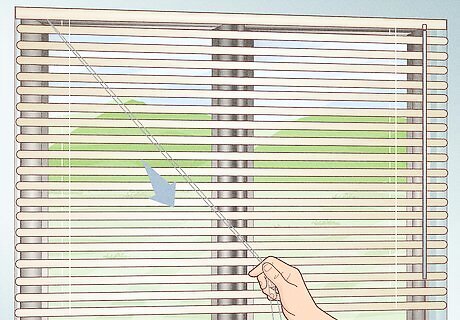
Lower the blinds by tugging the cord to the right at a 45-degree angle. Grip the cord firmly and pull to the right, which “unlocks” the string from the locking mechanism in your blinds. While you’re still holding the cord, release the slack on the string to bring your blinds down. Then, pull the cord to the left to lock your blinds in place. On some single-string blinds, pulling the cord to the left unlocks the string while pulling to the right locks it. Play around with your cord and see which direction does the trick. Venetian blinds, mini blinds, micro blinds, pleated shades, and cellular shades often use single-string systems. If you have especially big windows, your “single string” might actually be 4 strings tied together. Treat these 4 strings like a unified cord, and make sure that you’re pulling them all at the same time—otherwise, your blinds will close unevenly.
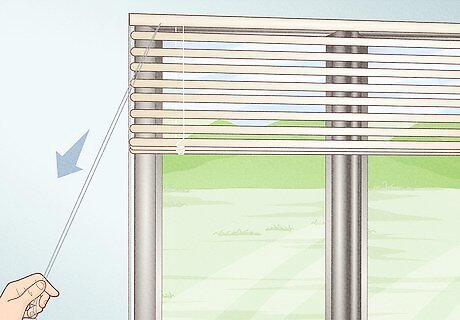
Raise the blinds by pulling on the cord and tugging it to the left. Firmly pull the cord towards you and lift the blinds to your desired height. Then, tug the cord to the left—this triggers the blinds’ locking mechanism and holds them in place. On some single-string blinds, you might have to tug the string to the right to lock them in place.
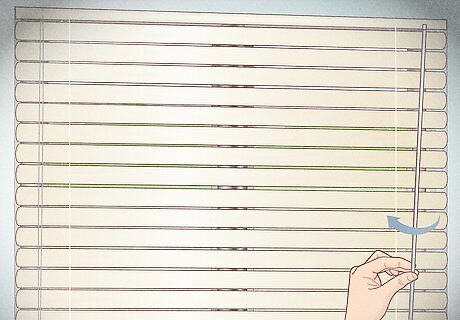
Rotate the wand to adjust your blinds’ lighting. Watch as the slats of your blinds open and close, allowing more or less light into your living space. Keep rotating the wand until you’re happy with the amount of lighting. Some blinds use 2 parallel strings to adjust the slats instead of a single wand. Just tug on 1 string to tilt the slats in one direction, and pull the other string to move the slats in the opposite. Alternate between strings until you’re content with the lighting.
Top Down-Bottom Up Blinds
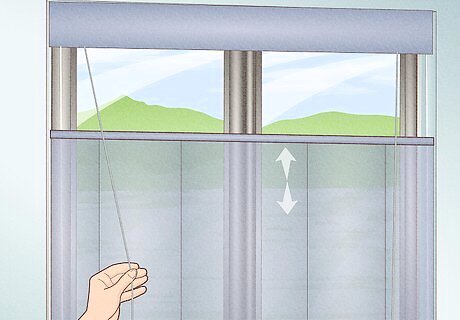
Lower and raise the top portion of the blinds with the left cord. Use this cord if you’d like to let some light in through the top portion of your windows rather than the bottom. Top down-bottom up blinds don’t have adjustable slats—instead, you “adjust” the blinds by lowering and raising them along the top and bottom. Cellular, Roman, pleated, and woven wood shades are sometimes designed in this style.
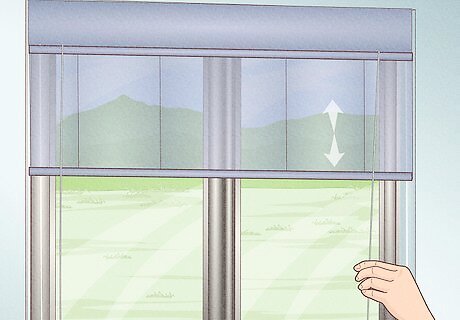
Lift and lower the bottom section of the blinds with the right cord. Tug on this string if you’d like to increase or decrease the amount of light shining through the lower half of your window. On some blinds, the left cord might control the bottom section of the blinds and the right cord might control the top. Tinker around a bit to see how your blinds function.

Lock or unlock your blinds by tugging either cord to the right or left. Pull down on the left or right string to raise the top or bottom portion of your blinds. Then, pull your cord to the right so your blinds stay put. To close your blinds, pull the cord to the left and release the slack until you’re satisfied with the height of your blinds. Lock everything down by tugging your cord to the right again. On some blinds, the locking mechanism might be reversed—on these, pulling to the left locks the cord while pulling to the right unlocks it.
Continuous-Cord Blinds
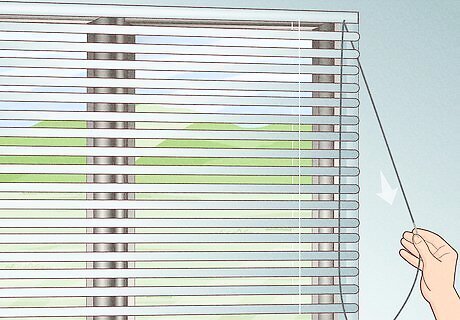
Close the blinds by continuously pulling on the back portion of the loop. Take a close look at your cord loop—the “front” portion is closer to you, while the “back” portion is closer to the window. Tug repeatedly on the back part of the loop to lower your blinds down. Continuous-cord systems are common with bigger, bulkier blinds.
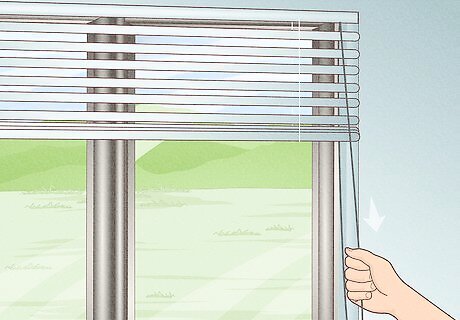
Lift the blinds by tugging along the front section of the cord. Pull continuously on this front portion until you’re happy with the height of your blinds.

Rotate the rod on the other side of the window to adjust the slats. Open and close any adjustable slats by twisting the rod hanging down from the top of the window. Just rotate the rod to the right or left to make your adjustments. Not all continuous-cord blinds come with adjustable slats.
Cordless Blinds
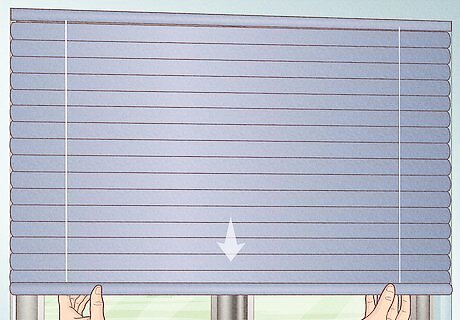
Close the blinds by dragging them down with your hands. Grip along the very bottom of the blinds with both hands, making sure that your hands are spaced evenly. Then, gently tug down on the blinds to manually cover up the windows. Cordless blinds don’t have any strings or rods attached for adjustments. If your blinds are completely bare, there’s a good chance that they’re cordless.
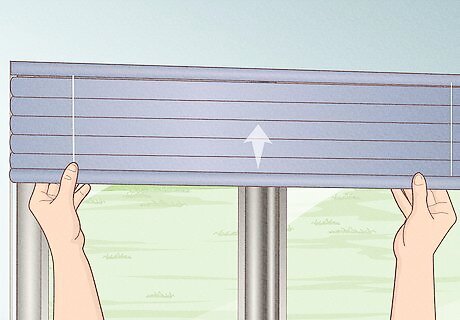
Open the blinds by manually pushing them up. Place both hands beneath the blinds and apply a little bit of pressure—the slats will automatically contract as you push. Continue adjusting the blinds until you’re happy with their height.
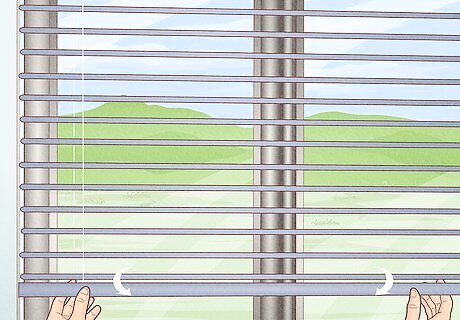
Tilt the bottom bar down to rotate the slats on cordless blinds. Use both hands to angle the bottom rail forwards or backwards—this adjusts the slats automatically. Keep tilting the rail until you’re satisfied with the amount of light that’s filtering into your room.
Blinds with Rods
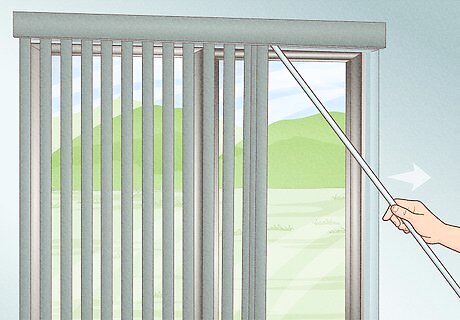
Pull on the rod to close the blinds. Blinds with rods are mounted on a horizontal track that’s controlled by a long rod. Tilt this rod at a 45-degree angle and continuously pull—this drags the slats across the window in a horizontal line and covers up the glass. The rod is parallel to the rest of the slats and is typically attached at the end. A rod system is most commonly used with vertical and panel blinds.
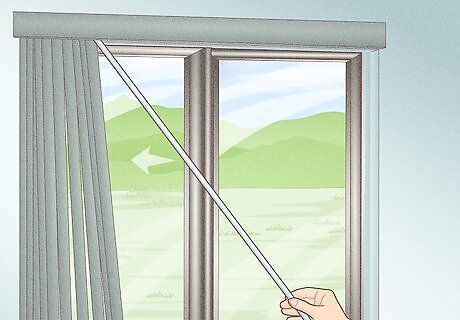
Push the rod to condense the slats and show off the window. While holding the rod at a 45-degree angle, push the slats down to one side of the track. This exposes some of the window and lets a little more light into your living space. Double-check that the slats are completely open and separated before you slide them together with the rod.

Twist the same rod to rotate the slats. Want little less (or more) light in the room? Just twist the rod to the left to adjust the slats. If the blinds don’t start to close, simply twist the rod in the opposite direction.




















Comments
0 comment